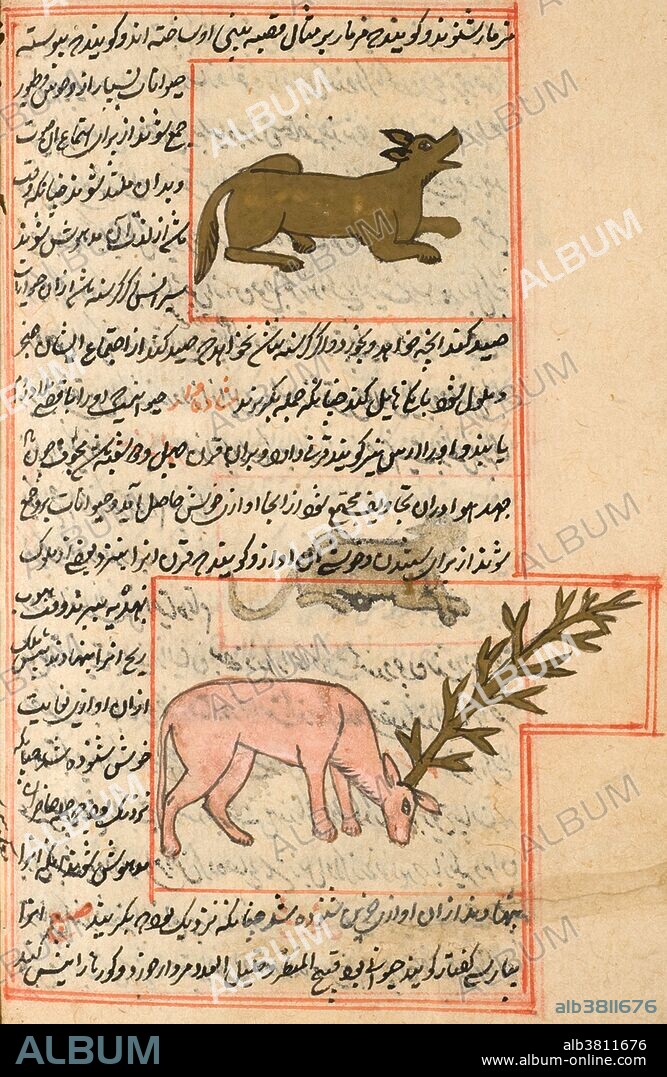alb3811676
Sironsor and Shadehvar, Legendary Creatures

|
Add to another lightbox |
|
Add to another lightbox |



Buy this image.
Select the use:

Title:
Sironsor and Shadehvar, Legendary Creatures
Caption:
On the right is al-Qazwini's Sironsor or Shironse, a mythical creature that was able to make music by breathing through a number of holes in its body connected to its respiratory system. Below it is Shadehvar (Shadhahvar), known as a Persian antelope with a single hollow branched horn. The wind would blow through it like a flute, and the pleasant music attracted other animals. It is thought to be the same creature the Roman naturalist Pliny the Elder described as a Unicorn, with the head of a deer and body of a horse. The Kitab Aja'ib al-makhluqat wa Gharaib al-Mawjudat, usually known as "The Cosmography" or "The Wonders of Creation," was compiled in the 13th century in what is now Iran or Iraq and is considered one of the most important natural history texts of the medieval Islamic world. The author Abu Yahya Zakariya ibn Muhammad ibn Mahmud-al-Qazwini (1203-1283), known simply as al-Qazwini, was one of the most noted natural historians, geographers and encyclopedists of the period. At the very end, the scribe has written a colophon praising Allah again and stating that he finished copying this manuscript in 1537.
Credit:
Album / Science Source / NLM
Releases:
Model: No - Property: No
Rights questions?
Rights questions?
Image size:
2700 x 4148 px | 32.0 MB
Print size:
22.9 x 35.1 cm | 9.0 x 13.8 in (300 dpi)
Keywords:
'AJA'IB AL-MAKHLUQAT WA-GHARA'IB AL-MAWJUDAT • 13TH CENTURY • 13TH • 1537 • 16 16TH XVI XVITH SIXTEENTH CENTURY • 16 CENTURY • 16TH CENTURY • 16TH • ABU YAHYA ZAKARIYA' IBN MUHAMMAD AL-QAZWINI • AL-QAZWINI • ARAB • ARABE • ARABIAN • ARABIC • ART • ARTWORK • COSMOGRAPHY, THE • DRAWING • HISTORIC • HISTORICAL • HISTORY • ILLUMINATED MANUSCRIPT • ILLUSTRATION • ILLUSTRATIONS • ISLAMIC • MANUSCRIPT • MANUSCRIPT, ILLUMINATED • MARVELS OF THINGS CREATED • MEDIEVAL • MIDDLES AGES • MIRACULOUS ASPECTS OF THINGS EXISTING • MOSLEM • MUHAMMAD AL-QAZWINI • MUSLIM • SCIENCE • TEXT • TREATISE • WONDERS OF CREATION • WRITING • XIII CENTURY • XVI CENTURY • ZAKARIYA AL-QAZWINI
 Pinterest
Pinterest Twitter
Twitter Facebook
Facebook Copy link
Copy link Email
Email
